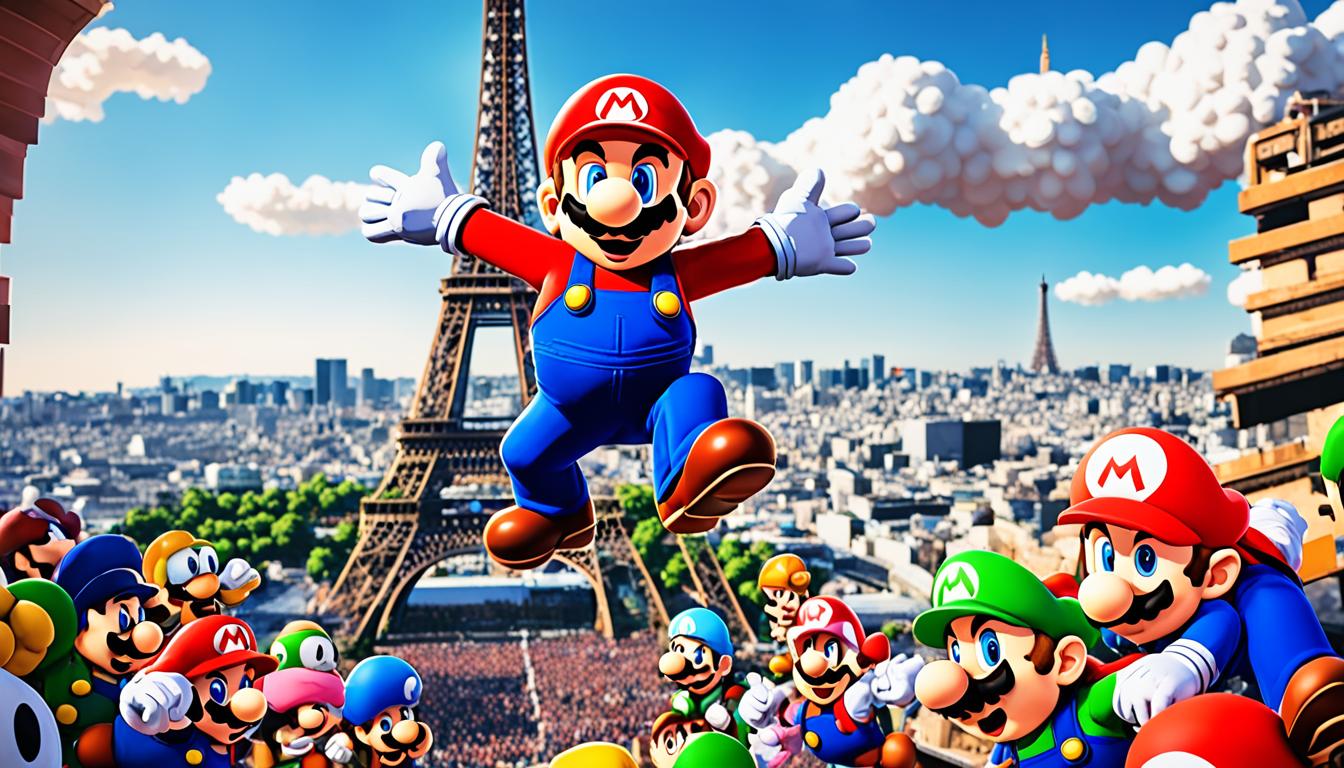Japan’s gaming industry has more than 75 million gamers. This contributes to a market worth about £16.2 billion. Japanese games significantly affect Western culture by mixing design elements, focusing on cultural themes, and giving birth to new genres. They are key players in the success of well-known franchises.
Key Takeaways:
- Japanese games have shaped the gaming industry and influenced popular culture.
- Japanese game design blends Japanese and Western elements to create unique experiences.
- Japanese games have introduced cultural themes and narratives to Western audiences.
- The success of Japanese games has led to the development of new genres and subgenres.
- Japanese game aesthetics emphasize storytelling, art, and innovative gameplay mechanics.
Blurring the Lines Between “Western” and “Japanese”
The world of gaming keeps changing. The lines between “western” and “Japanese” game designs are blending more and more. This blending is creating games that people from the West find more familiar.
Western game makers have really impacted Japanese games. They have helped steer the course of Japanese game design. For example, “Osu! Tatakae! Ouendan” didn’t sell massively in the U.S. when it first came out in 2005. But, its western version, “Elite Beat Agents,” did well when it came out in 2006. This change of track showed how games can be both from somewhere specific and for everyone.
“Elite Beat Agents” included American elements, making the game more appealing in the West. Despite this, it kept its manga-style look. Doing this made the game both true to its roots and fun for the global audience.
Now, it’s common for Japanese games to add elements that appeal to the West. Game developers understand the need to keep what makes Japanese games special. They also add things to their games that suit Western tastes.
One great example is Metal Gear Solid 4. It was tailored to entice Western gamers more. It became a hit because of changes in controls and camera view. This success shows how games can bring together the best of Japanese and Western designs.
Yet, not every attempt to mix cultures in games works perfectly. Take Shadows of the Damned, for instance. It was created by a top Japanese team but didn’t do well with players in Japan or the U.S. This shows that mixing cultures can be tricky.
Even with some missteps, Japanese game makers keep trying to please Western players. A notable effort comes from Capcom. They joined forces with Canadian teams for games like Dead Rising 2 and Resident Evil 6. This shows a clear effort to understand what Western players like.
Capcom also did something fresh with Dragon’s Dogma, an action RPG. This game included features more common in Western games, like detailed maps and moral choices. It showed a willingness to change and appeal to many people.
The give and take between Western and Japanese developers is mutual. Each side takes ideas from the other. This exchange has led to new types of RPGs. Games like NieR: Automata and The Witcher blend Eastern and Western traits well. They give players a mix of stories, gameplay, and art that’s both fresh and familiar.
Japanese RPGs continue to shape Western RPGs. The love for games like action RPGs and JRPGs outside Japan proves this. Japanese game design’s influence remains strong.
Key Takeaways:
- Japanese developers are adopting ideas from Western developers, resulting in games that feel more familiar to Western audiences.
- The success of Metal Gear Solid 4: Guns of the Patriots demonstrated the appeal of culturally fused games.
- Japanese developers, such as Capcom, have made strategic moves to cater to Western consumer interests.
- The trend of cultural fusion in game development is not one-sided, with Western developers also drawing inspiration from Japanese games.
- Japanese RPGs continue to influence the RPG genre, with traits from both genres being incorporated into modern RPGs.
Metal Gear Solid 4: A Turning Point
Metal Gear Solid 4: Guns of the Patriots was a big moment for the series. It aimed to get more fans in the west. They brought in Ryan Payton, an American, to help. His work improved the controls and camera, making it easier for people in the west to play.
The changes for western fans were a hit. Metal Gear Solid 4 did very well money-wise. This showed that mixing influences from both sides can work great in game design.
Metal Gear Solid 4 became a standout. It mixed Japanese and western designs well. This made it appeal to many. It was liked in Japan and the West because of its action and stealth mix.
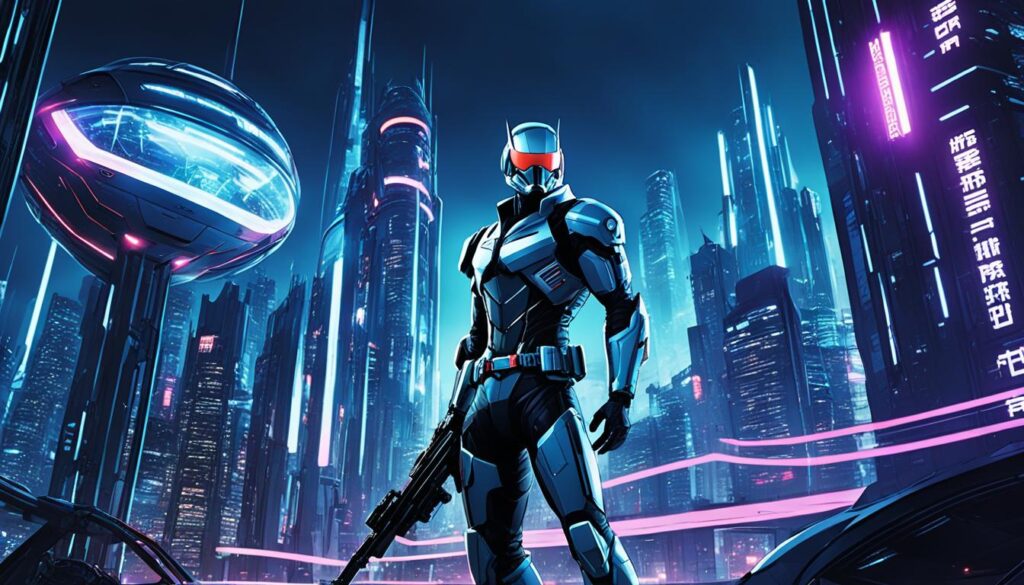
At the Tokyo Game Show, big crowds gathered for Metal Gear Solid 4. It was one of the most awaited games. The developers worked hard to make the controls smooth. This made the game much easier to play.
New moves and weapons were added to Snake’s abilities. There was also an auto-aim feature now. The new camera view was thanks to games like Gears of War. It suited players from Japan and the West well.
Explaining controls was key. They knew players had certain expectations from past games. Some in Japan got sick from certain camera views. So, they were careful with choosing how the game shows its world.
Metal Gear Solid 4 borrowed the over-the-shoulder view, like in Resident Evil 4. This pleased both Japanese and Western players. They added a new feature where you can switch camera shoulders. This made control better for everyone.
Ryan Payton and the team behind Metal Gear Solid 4 did a great job. They found a good balance between east and west game elements. This set a new benchmark for Japanese games. It made the series even bigger, with fans all over the world.
Shadows of the Damned: A Cultural Fusion
Shadows of the Damned brings together Japanese and American creativity. It’s a game by the well-known Goichi Suda, or SUDA51. The goal was to blend both cultures in game design.
They mixed the grit of American games with Japanese quirk and story in Shadows of the Damned. This game draws a lot from Quentin Tarantino’s films. So, it’s full of dark humor and stylized violence.
“[Shadows of the Damned’s vision] comes from Quentin Tarantino, teaching us about movies and games. There are Japanese touches, but it’s for shooter fans. We’re showing a new game style.” – Goichi Suda
Integrating Japanese and American ideas is tricky, as Shadows of the Damned found out. It didn’t do well in Japan or the US. Its struggles point to the difficulties of mixing different cultures in games.
There’s a fine line to walk in blending Eastern and Western gaming tastes. For instance, Western players prefer more straightforward action. But, this doesn’t always match Japan’s focus on deep stories and mechanics. Developers are working on ways to blend these preferences better.
Japanese Talent and American Influence: A Tricky Balance
Connecting with Western gamers led to changes in some Japanese games. Ninja Gaiden 3 was one of them, making encounters simpler to appeal more broadly. But, this move faced criticism for its impact on gameplay. It’s a balance between accessibility and core gameplay that is hard to strike right.
The melding of Japanese and Western influences continues. Capcom, for example, has been successful in creating games that draw from both sides. Titles like Dead Rising 2, made by a Canadian team, aim to please a global audience.
The Future of Cultural Fusion in Game Development
Shadows of the Damned is part of a trend in Japan’s game industry. Developers are aiming to resonate with Western gamers. This means more Western elements in their games.
Looking forward, finding the right mix will be crucial. Japanese games can stand out globally by being tailored for both local and international players. This offers a promise for more universally appealing games.
| Japanese Talent | American Influence | |
|---|---|---|
| Development | Developed by Japanese talent, showcasing Japanese design elements and storytelling. | Incorporated American influences, drawing inspiration from filmmaker Quentin Tarantino. |
| Gameplay | Blended Eastern and Western gameplay mechanics for a unique gaming experience. | Emphasized gritty action and dark humor, reflecting American gaming sensibilities. |
| Audience Response | Did not resonate well with Japanese and American audiences, resulting in poor sales. | Highlighted the challenges of cultural fusion in game development. |
Capcom’s Westernization Efforts
Capcom, a major game developer from Japan, has noticed the strong influence of the West. They are reaching out to Western markets by trying new ways to make games. They have started working with Western studios. One example is Dead Rising 2, made by a Canadian studio. It kept the fun that both Japanese and Western players love.
Capcom’s move to the West doesn’t stop at making games with Western help. They also bring Western ideas into their Japanese games. For example, Dragon’s Dogma mixes European and American themes with Japanese RPG style. This blend makes games that everyone around the world can enjoy.
Capcom is also letting North American teams work on unusual Resident Evil games. This change brings new ideas and a different view to their well-known game series. It’s a way to appeal more to Western players and grow the gaming world in a diverse way.
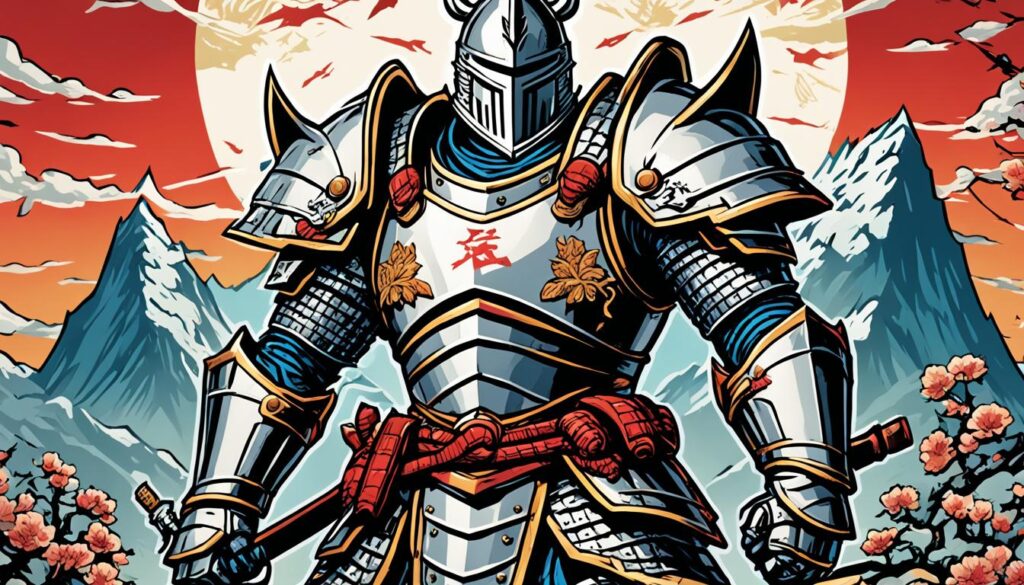
Capcom’s Localization Challenges
Capcom really wants their games to speak to all players, no matter where they are. Part of this is translating the games, but it’s more than just changing the words. They also work on jokes, designs, and making sure the games fit in with different cultures. This is called localization.
One issue with localization is how to make the games fit everyone without leaving some people out. Capcom works on making sure games are friendly to all, without making big changes to the core game. This is a hard job and takes a lot of care.
Localization is key for games to reach more players all over the world. But, it needs to be done with care to not lose what makes the games special. Finding the right path between changing for everyone and staying true to the original games is a big challenge.
Some people don’t like how Capcom changes their games for different places. There’s a big discussion happening in the game world about this. It’s about respecting different cultures while keeping the heart of the game true. Capcom and others are figuring out how to do this well.
Capcom’s Commitment to a Global Gaming Landscape
Capcom wants players everywhere to enjoy their games. That’s why they put a lot of effort into making games for the whole world. Their goal is that every player feels welcome and at home in their games.
By working on how games are localized, Capcom breaks down language and culture walls. This way, all players can dive into the game’s world easily. They aim to create games where everyone can find a bit of themselves, no matter where they come from.
Capcom’s Westernization Efforts and Game Development Collaborations
| Game Title | Development Collaboration |
|---|---|
| Dead Rising 2 | Canadian studio |
| Dragon’s Dogma | Incorporation of European and American ideas |
| Resident Evil titles | Collaboration with North American developers for atypical games |
Capcom’s journey toward the West and beyond is essential for making games that welcome everyone. As they face challenges, the gaming future is set to be more global and diverse. It’s about keeping games special while being for everyone.
Japanese Games Leading to Hit TV Shows
Japanese video games have truly shaped today’s pop culture, influencing not just games but also TV. Many famous Japanese games have become beloved anime shows or TV series. They capture the hearts of fans all over the world. Let’s look at how these games have made their mark on TV and popular culture in the West.
The perfect example is Pokémon. It started as a video game series by Game Freak. Quickly, it became a global hit, resulting in a beloved anime. This adapted TV series showed the world of Pokémon trainers. It highlighted their endeavors to be the best. With its fun characters and engaging plots, Pokémon is now a part of global culture. It teaches people about Japan’s feel and stories.
Super Mario Bros. is another hit that moved from games to TV. Created by Nintendo, the franchise is a hit in both worlds. “The Super Mario Bros. Super Show!” turned Mario and friends into animated favorites. This show mixed game culture into its funny adventures. It clearly shows how Japanese games have influenced Western culture.
“Japanese video games have not only inspired anime adaptations but have also become a driving force behind the integration of video game culture into TV shows worldwide.”
But Japanese games’ TV impact isn’t just about direct adaptations. Even shows without a single game title often celebrate game culture. They show respect for how Japanese games affect Western tastes. For example, “Wipeout” took cues from “Katamari Damacy”. It introduced a wider audience to its quirky fun.
Combining game culture with TV proves how far Japanese games’ influence reaches. It celebrates the creativity of Japanese developers. And it recognizes the crucial part game culture plays in shaping what we love all around the world.
Japanese Games Successfully Adapted into TV Shows
| Game | TV Adaptation | Genre |
|---|---|---|
| Pokémon | Pokémon: The Animated Series | Anime |
| Super Mario Bros. | The Super Mario Bros. Super Show! | Animated / Live-action |
| Wipeout | Game show inspired by “Katamari Damacy” | Game show |
The success of these adaptations shows the key role Japanese games play in TV storytelling. They bring dynamic tales, lovable characters, and rich worlds to our screens. The influence of Japanese games on TV is clear, persisting in today’s popular culture.
Pushing the Mobile Gaming Envelope
Japanese games have led the way in mobile gaming. Pokémon Go, a landmark project by Nintendo and Niantic, showed how big mobile gaming could be. It stormed the globe, becoming the most downloaded app ever at launch. This showed how much people love mobile games.
Pokémon Go’s success revealed a new world of mobile gaming. It encouraged others to make games like it. The game mixed real-world sights with catching Pokémon, drawing players in. This was a big change for mobile gaming.
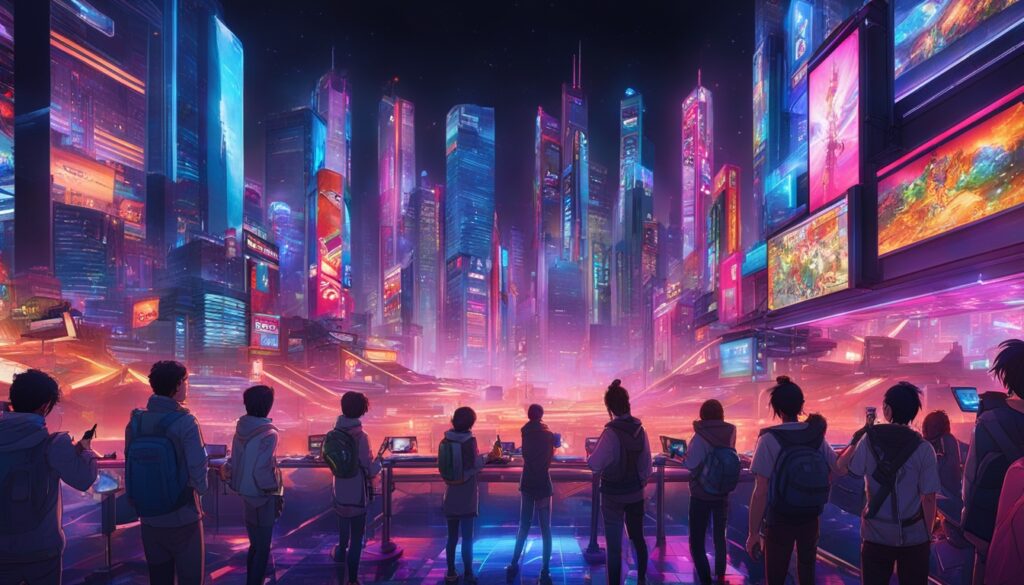
Since Pokémon Go, games that mix real life with play have sprung up. Jurassic World Alive and The Walking Dead: Our World use the same idea. They prevent the players from sitting still, keeping them moving in the real world.
Japanese games keep making big waves in mobile gaming. They come up with new and exciting games that use the latest tech. These games pull people in by making them part of the action. Japanese game creators are definitely shaping the future of mobile gaming.
Musical Influence of Japanese Games
Japanese composers have greatly influenced the music in video games. One key figure is Nobuo Uematsu, famous for creating music for Final Fantasy. He mixed classical tunes, like Bach’s, into the memorable Final Fantasy scores.
Final Fantasy games changed music in gaming. They were some of the first with orchestras, singing, and complex music. This showed how much feeling and art games’ music could have. Uematsu’s music helped tell the game stories better and made players feel part of them.
Uematsu did more than just work on Final Fantasy. He started The Black Mages, a band that mixed heavy metal with game music. Their style made Uematsu’s music even more popular, showing that game music could be enjoyed by anyone.
Progressive Rock Inspiration
Uematsu says UK progressive rock, like Emerson, Lake, and Palmer, inspired him a lot in making music for the Final Fantasy games.
Koji Kondo is another big name from Japan. He’s known for his music in Mario and Zelda games. He got ideas from UK bands like Deep Purple as well as Emerson, Lake & Palmer. Kondo grew up with progressive rock, starting to play keyboards at age five.
Progressive rock shaped the big, detailed songs in Kondo’s games. Mixing different music types gave Mario and Zelda a special sound. This made the games more real and fun for players to dive into.
Nobuo Uematsu, Koji Kondo, and others have made video game music popular worldwide. Their amazing scores have been celebrated in concerts and remixes. They have made a lasting mark on both gaming and music culture.
Cultural Influence Beyond Games
Japanese games not only shake up the gaming world but also leave a deep mark on global culture. They show off Japanese history, traditions, and themes. Take games like Assassin’s Creed and Ghost of Tsushima. They dive into Japanese culture, getting Western folks hooked and spreading love for Japanese art and stories.
Assassin’s Creed leads you through time, whether it’s ancient Greece, Egypt, or feudal Japan. In Assassin’s Creed: Ghost of Tsushima, you’re taken to the time of samurais. It crafts a detailed, Japanese-filled world where you become part of the samurai stories.
| Game | Influence |
|---|---|
| Assassin’s Creed | It uses real historical places and people to showcase world cultures, including Japan in the Ghost of Tsushima chapter. |
| Ghost of Tsushima | This game throws you in the samurai era with breathtaking sights, traditional Japanese buildings, and lessons in honor. The game highlights bushido, the samurai way of life. |
These games do more than entertain; they teach. They give folks in the West a peek at Japan’s culture and past. Players explore famous spots, talk to historical figures, and learn about Japan’s rich traditions.
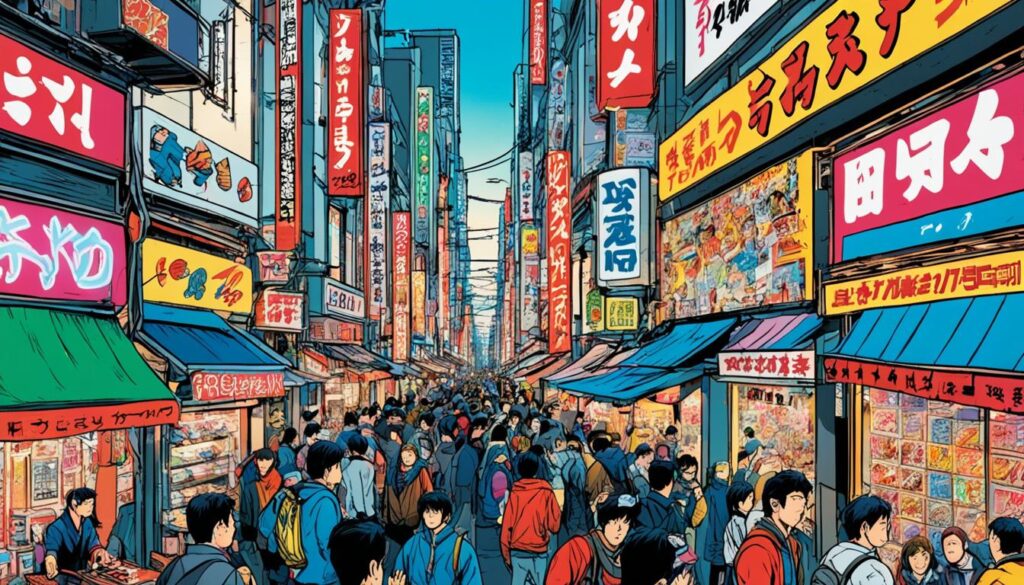
Games like Assassin’s Creed and Ghost of Tsushima hold up a mirror to Japan’s beauty. They’re making folks all over appreciate Japan’s rich history and artistry.
As these games become hits, they open up Japanese culture to players. They spark interest and push people to look more into Japan’s traditions, arts, and tales. Japanese games don’t just entertain; they connect cultures and open eyes to Japan’s amazing heritage.
Designing New Genres and Subgenres
Japanese game creators have greatly impacted the gaming world by inventing new genres and subgenres. They are responsible for the popular role-playing game (RPG) genre which started in Japan. RPGs are known for their deep stories, character customization, and strategic gameplay.
Games like Final Fantasy from Japan have shown the world what RPGs can be. They tell complex stories that draw players in. Players get to explore large worlds and make choices that change how the game ends. Since then, the RPG genre has grown and changed, always bringing new ideas.
One key innovation from Japanese designers is the use of cutscenes. Cutscenes are like movie scenes in games. They tell the story in a more immersive way. This method has become very common and is now seen in games from all over.
Japanese creators have also added cool features to RPG games to make them more fun. Monster Hunter made the action RPG genre exciting with its focus on quick fights. Games like Persona combine RPGs with social sims, putting a big emphasis on growing your character’s story and relationships.
Aside from RPGs, Japanese creators have influenced many other types of games. They’ve made action-adventures with huge open worlds and games where you shape the story through your choices. Their creative ideas keep the gaming world fresh and full of new adventures.
Japanese Games and Their Impact on TV Shows
Japanese video games have made a big impact on TV shows. They inspired both adaptations of anime and original series. These shows mix entertainment with the culture of Japanese games.
“Wipeout” is one TV show that reflects this influence. It was inspired by “Katamari Damacy,” a famous game. “Katamari Damacy” brought a unique, quirky style, and “Wipeout” used that to make an exciting competition. This show attracted fans of games and TV with its fast-paced, obstacle-filled races.
“Wipeout” took cues from the unique style of Japanese game shows. It mixed video game elements with physical challenges, creating something new in the TV world.
Not just through direct adaptations, but video game culture has seeped into many TV genres. Sitcoms, dramas, and more have included aspects of video game culture. This shows how far-reaching Japanese games’ influence is in the TV industry.
You might see this influence when characters talk about popular games. Sometimes, whole episodes are about gaming, showing the big role games have in our culture.
By bringing gaming culture into TV shows, they make gaming more relatable. They help connect gamers with non-gamers, making TV more engaging for everyone.
This blending of video game culture in TV shows proves the power of Japanese games. They shape entertainment far beyond their original industry.
Showing video game culture on TV also spreads the global influence of Japanese games. It introduces viewers to Japanese creativity, stories, and game design. In the end, it deepens our understanding and love for the game culture.
Mobile Gaming Revolution
Japanese games are leading the way in the mobile gaming world. They’re taking full advantage of new mobile tech. This has changed how we play games on our phones. A great example is Pokemon Go, made by Nintendo and Niantic.
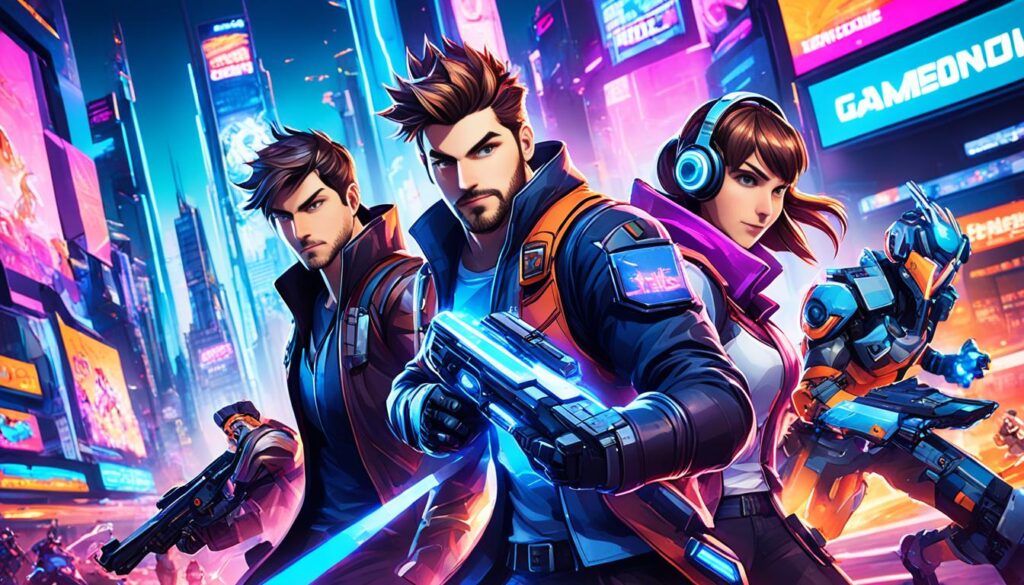
Pokemon Go went beyond what we thought was possible on mobile. It used augmented reality to make the game feel real and fresh. It quickly became the most popular gaming app ever. It also made tons of money.
The success of Pokemon Go showed how much people love Japanese mobile games. And it inspired more games based on Japan’s culture. Mobile games offer easy access to fun and exciting worlds on the go.
Now, mobile gaming is a big part of the gaming market. Japan is the third-largest in the world for how much people spend on mobile games. This is after the U.S. and China. Several reasons are behind this rapid growth.
New Genres and Accessibility
New types of mobile games, like puzzles and casual games, have won over many players. They’re easy to get into and fun to play. The idea of playing for free but buying items to help in the game is a hit, making a lot of money.
Smartphones have made playing games simpler and more available than ever before. They’re in the hands of millions, giving everyone a large game selection. This has sparked a big growth in mobile gaming, especially in new markets.
Connectivity and Multiplayer Gaming
5G has made multiplayer mobile gaming better. It makes playing with others in real-time smoother and more fun. This boosts social interaction in games.
Adding social features, like leaderboards and chat, has built a sense of community among players. Competition and sharing experiences keep attracting people to mobile gaming.
Global Impact and Continued Growth
Japanese games have traveled far beyond Japan, capturing billions of players. Hits like Candy Crush and Angry Birds show how popular they are worldwide.
Mobile gaming keeps growing fast. With better tech and stronger smartphones, games will get even more advanced. The future could bring mind-blowing virtual and augmented reality games.
| Japanese Mobile Gaming Statistics | |
|---|---|
| Japanese mobile gaming industry consumer spending ranking | 3rd (after the U.S. and China) |
| Estimated revenue generated by CyGames’ Uma Musume: Pretty Derby within two years of its launch | $2 billion |
| Percentage increase in PC gamers in Japan in 2021 compared to the previous year | 6.4% |
| Percentage of Japanese gamers engaged in PC gaming | Less than 20% |
| Percentage of Japanese gamers engaged in console gaming | Around 60% |
| Percentage of Japanese gamers engaged in mobile gaming | 90% |
Japanese games have truly redefined how we play and think about gaming. As our tech gets better, Japanese game makers will bring us more incredible stories and adventures. They’re definitely leading the charge in the gaming world.
Japanese Games and the Music Industry
Japanese video games have changed not just the gaming scene but also music. Games like Final Fantasy have pushed video game music into the spotlight. They’ve shown it’s a real and loved music genre.
Nobuo Uematsu is a key composer in this movement. He’s the first to write music for the Final Fantasy series. His work, like the famous “One-Winged Angel,” is adored globally and stands as a pinnacle for video game music.
Live shows starring video game music have been key to spreading its appeal. These concerts have full orchestras playing famous game songs. They offer fans a unique and unforgettable experience. Shows such as Video Games Live and Distant Worlds have unified with orchestras to present entire concerts, known for selling out.
Video game music has also drawn in new classical orchestra enthusiasts. The interest in game soundtracks has led to concerts covering these songs. It has also built special interest groups and events like MAGFest in the US. These celebrations unite fans and musicians in their love for video game music.
Japanese video games also greatly impact worldwide popular culture. They influence manga, anime, movies, and TV shows. The stories and worlds in these games inspire a range of media and entertainment.
In wrapping up, Japanese video games truly change how we see and enjoy music and entertainment. The mix of interactive play and creative music has given rise to a special and influential music genre. This style remains loved by people everywhere.
Conclusion
Japanese games have greatly impacted Western culture. They mix design elements from both sides and have become a major part of the gaming world. They introduce unique stories and settings to Western players.
These games have not just enhanced the gaming industry. They have also affected areas like anime and TV shows. Adaptations like Stein’s;Gate show how well-loved and influential they are in the West.
The future holds more potential for cultural blending in game development. The support from Japan’s government and its advanced tech scene bode well. This promises further growth and unique gaming experiences.
Japanese games excel in storytelling and offering players choices. They encourage deep emotional connections with the games. This unique approach continues to influence how games are made and played.
FAQ
What is the influence of Japanese games on Western culture?
Japanese games have greatly shaped Western culture. They have impacted the gaming field and various areas of pop culture.
How have Japanese games blurred the lines between “Western” and “Japanese”?
Japanese studios now use ideas from the West. This has made games more relatable to the West. It shows a blended culture in game making.
Can you give an example of a game that successfully balanced Japanese and Western design elements?
A: Metal Gear Solid 4: Guns of the Patriots is a prime example. It combined Western appeal with Japanese design. This balanced mix was a hit for game design.
Which game exemplifies recent cultural fusion in Japanese games?
A: Shadows of the Damned stands out. It mixes Japanese and American styles. This highlighted the challenges in blending cultures in games.
How is Capcom catering to Western audiences?
Capcom gave Dead Rising 2 to a Canadian team. They also infused European and American ideas into games like Dragon’s Dogma. This shows how they’re changing up their game-making process.
How have Japanese games influenced hit TV shows?
Games like Pokemon and Super Mario have become icons. They led to successful anime and inspired TV shows. These shows reflect video game culture.
How have Japanese games revolutionized the mobile gaming industry?
With the launch of Pokemon Go, mobile gaming changed. It became the most downloaded app. It also inspired others to make similar games.
Who are some influential composers in the video game industry?
Composers like Nobuo Uematsu are big names. They’ve pushed video game music forward. They’ve helped modernize game soundtracks.
How have Japanese games contributed to a global appreciation of Japanese art and narrative?
Games like Assassin’s Creed and Ghost of Tsushima highlight Japanese culture. They introduce Western audiences to Japan’s history. This promotes a global love for Japanese art and stories.
How have Japanese developers influenced the design of video game genres and subgenres?
Japanese developers have created new video game genres. They are the inspiration for RPGs around the world. They brought in new ways to play and tell stories.
How have Japanese games influenced TV shows unrelated to specific games?
TV shows have started showing game culture without being about games directly. This reflects Japan’s broad impact on Western culture.
How have Japanese games contributed to the mobile gaming revolution?
Japanese game makers pushed mobile tech further with Pokemon Go. It became a global hit. It also inspired other games with a Japanese twist.
How have Japanese games impacted the music industry?
Composers like Nobuo Uematsu changed game music. Their work in games like Final Fantasy made game music popular. It opened the door for live performances and remixes.
What can we expect for the future of the influence of Japanese games on Western popular culture?
We will see continued blending of East and West in games. This will lead to more cultural mixing. It will also bring new changes to the gaming world.
Source Links
- https://www.japannakama.co.uk/the-cultural-impact-of-japanese-video-games/
- https://medium.com/@shotayamashita223/influence-of-japanese-culture-on-game-design-exploring-the-impact-on-the-gaming-industry-f2cb8075d42f
- https://digitalcommons.ursinus.edu/cgi/viewcontent.cgi?article=1005&context=eastasia_hon
- http://henryjenkins.org/blog/2006/12/games_as_national_culture_the.html
- https://www.ign.com/articles/2012/01/12/the-westernization-of-japanese-games
- https://screenrant.com/jrps-western-differences-mass-effect-skyrim-final-fantasy/
- https://www.gamedeveloper.com/production/infiltrating-kojima-productions-ryan-payton-talks-metal-gear-solid-4
- https://gamefaqs.gamespot.com/boards/926596-metal-gear-solid-4-guns-of-the-patriots/42089850
- https://suda51.fandom.com/wiki/Cultural_references_in_SUDA51’s_works
- https://www.smashjt.com/post/capcom-localization-swings-the-western-rainbow-sword
- https://en.wikipedia.org/wiki/Japanese_pop_culture_in_the_United_States
- https://en.wikipedia.org/wiki/Japanese_popular_culture
- https://gamefaqs.gamespot.com/boards/916373-pc/79676676
- https://medium.com/@shotayamashita223/the-influence-of-japanese-video-games-worldwide-7cad998d3086
- https://adamflip.wordpress.com/2013/12/10/progressive-rock-and-japanese-video-game-music/
- https://daily.redbullmusicacademy.com/2016/11/my-life-in-games
- https://gamestudies.org/1302/articles/picard
- https://www.ejable.com/japan-corner/japanese-culture/otaku-culture/
- https://www.resetera.com/threads/japanese-games-and-cultural-appropriation.154390/
- https://www.gamedeveloper.com/design/the-genres-of-tomorrow-
- https://www.japanhousela.com/articles/the-impact-of-manga-and-anime/
- https://en.wikipedia.org/wiki/Video_games_in_Japan
- https://www.gamesindustry.biz/japans-galapagos-syndrome-shows-signs-of-globalization
- https://www.linkedin.com/pulse/revolutionizing-gaming-industry-impact-smartphones
- https://theconversation.com/how-video-game-soundtracks-are-influencing-a-new-generation-of-musicians-and-music-lovers-219423
- https://restaurants-guide.tokyo/column/the-history-of-japanese-traditional-music/
- https://medusajapan.com/japans-video-game-industry-a-global-leader-in-innovation/
- https://www.linkedin.com/pulse/perfect-endings-multi-choice-conclusion-video-game-narratives-jones
- https://steamcommunity.com/app/319630/discussions/0/494632338495136283/?l=japanese
